M-commerce Usage Pattern Report
VerifiedAdded on 2019/12/03
|13
|3475
|467
Report
AI Summary
This report provides a comprehensive analysis of m-commerce, its usage patterns, and associated challenges. It explores current and future trends, examining various business models and the critical '8-second rule' of internet usability. The report delves into the security concerns surrounding m-commerce transactions, highlighting the need for secure purchase history records and addressing user anxieties about privacy and data breaches. The impact of m-commerce on individuals' lives is discussed, covering its applications in various sectors and the widespread use of mobile technologies. Different wireless technologies employed in m-commerce are also examined, along with recommendations for enhancing security and addressing limitations. The report concludes by emphasizing the benefits of m-commerce while acknowledging its drawbacks and suggesting areas for future research.
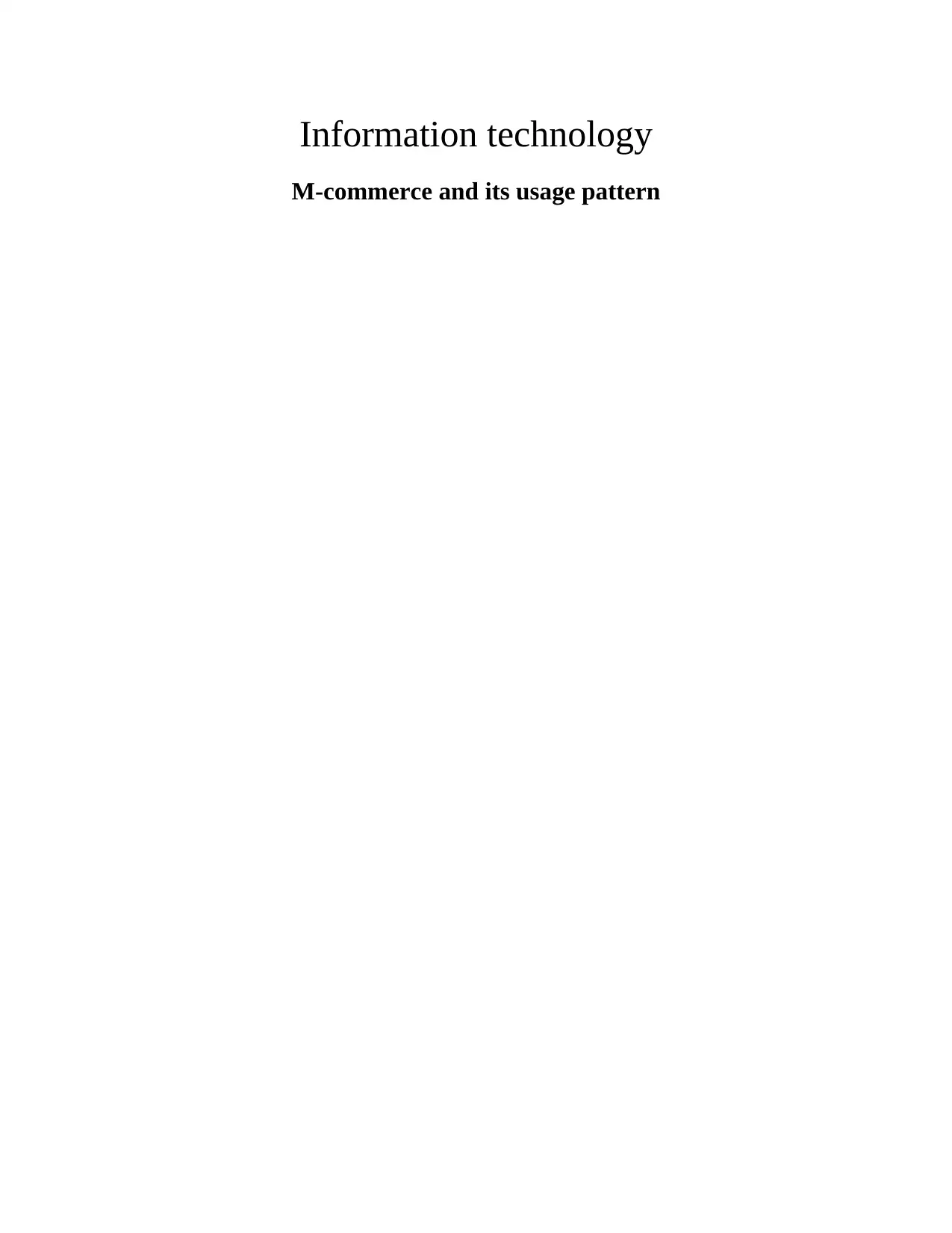
Information technology
M-commerce and its usage pattern
M-commerce and its usage pattern
Paraphrase This Document
Need a fresh take? Get an instant paraphrase of this document with our AI Paraphraser
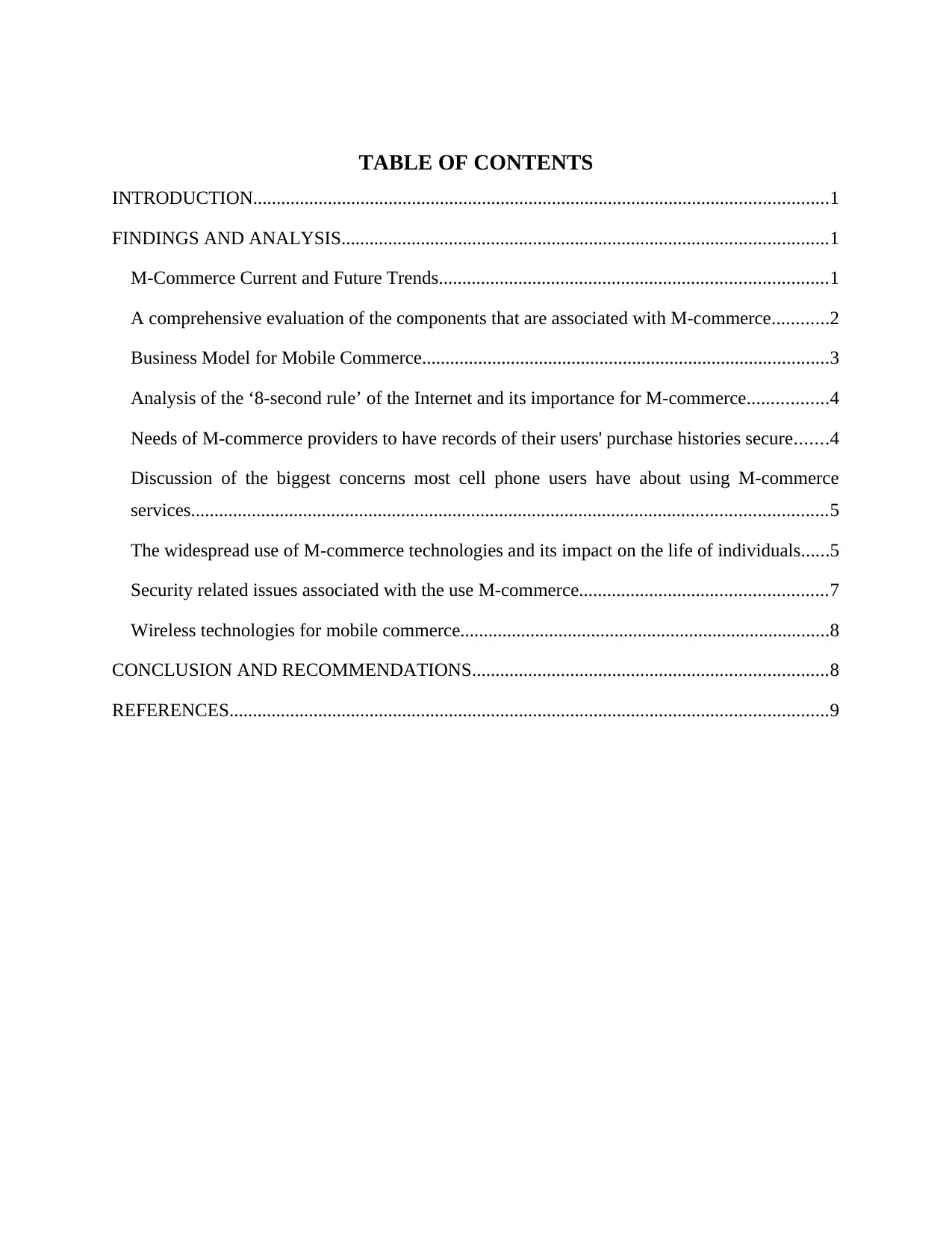
TABLE OF CONTENTS
INTRODUCTION...........................................................................................................................1
FINDINGS AND ANALYSIS........................................................................................................1
M-Commerce Current and Future Trends...................................................................................1
A comprehensive evaluation of the components that are associated with M-commerce............2
Business Model for Mobile Commerce.......................................................................................3
Analysis of the ‘8-second rule’ of the Internet and its importance for M-commerce.................4
Needs of M-commerce providers to have records of their users' purchase histories secure.......4
Discussion of the biggest concerns most cell phone users have about using M-commerce
services........................................................................................................................................5
The widespread use of M-commerce technologies and its impact on the life of individuals......5
Security related issues associated with the use M-commerce.....................................................7
Wireless technologies for mobile commerce...............................................................................8
CONCLUSION AND RECOMMENDATIONS............................................................................8
REFERENCES................................................................................................................................9
INTRODUCTION...........................................................................................................................1
FINDINGS AND ANALYSIS........................................................................................................1
M-Commerce Current and Future Trends...................................................................................1
A comprehensive evaluation of the components that are associated with M-commerce............2
Business Model for Mobile Commerce.......................................................................................3
Analysis of the ‘8-second rule’ of the Internet and its importance for M-commerce.................4
Needs of M-commerce providers to have records of their users' purchase histories secure.......4
Discussion of the biggest concerns most cell phone users have about using M-commerce
services........................................................................................................................................5
The widespread use of M-commerce technologies and its impact on the life of individuals......5
Security related issues associated with the use M-commerce.....................................................7
Wireless technologies for mobile commerce...............................................................................8
CONCLUSION AND RECOMMENDATIONS............................................................................8
REFERENCES................................................................................................................................9

LIST OF FIGURES
Figure 1: Growth of mobile commerce...........................................................................................1
Figure 2: M-commerce transactions................................................................................................2
Figure 3: Mobile share of e-commerce transactions........................................................................6
Figure 4: Security issues associated with M-commerce..................................................................7
Figure 1: Growth of mobile commerce...........................................................................................1
Figure 2: M-commerce transactions................................................................................................2
Figure 3: Mobile share of e-commerce transactions........................................................................6
Figure 4: Security issues associated with M-commerce..................................................................7
⊘ This is a preview!⊘
Do you want full access?
Subscribe today to unlock all pages.

Trusted by 1+ million students worldwide
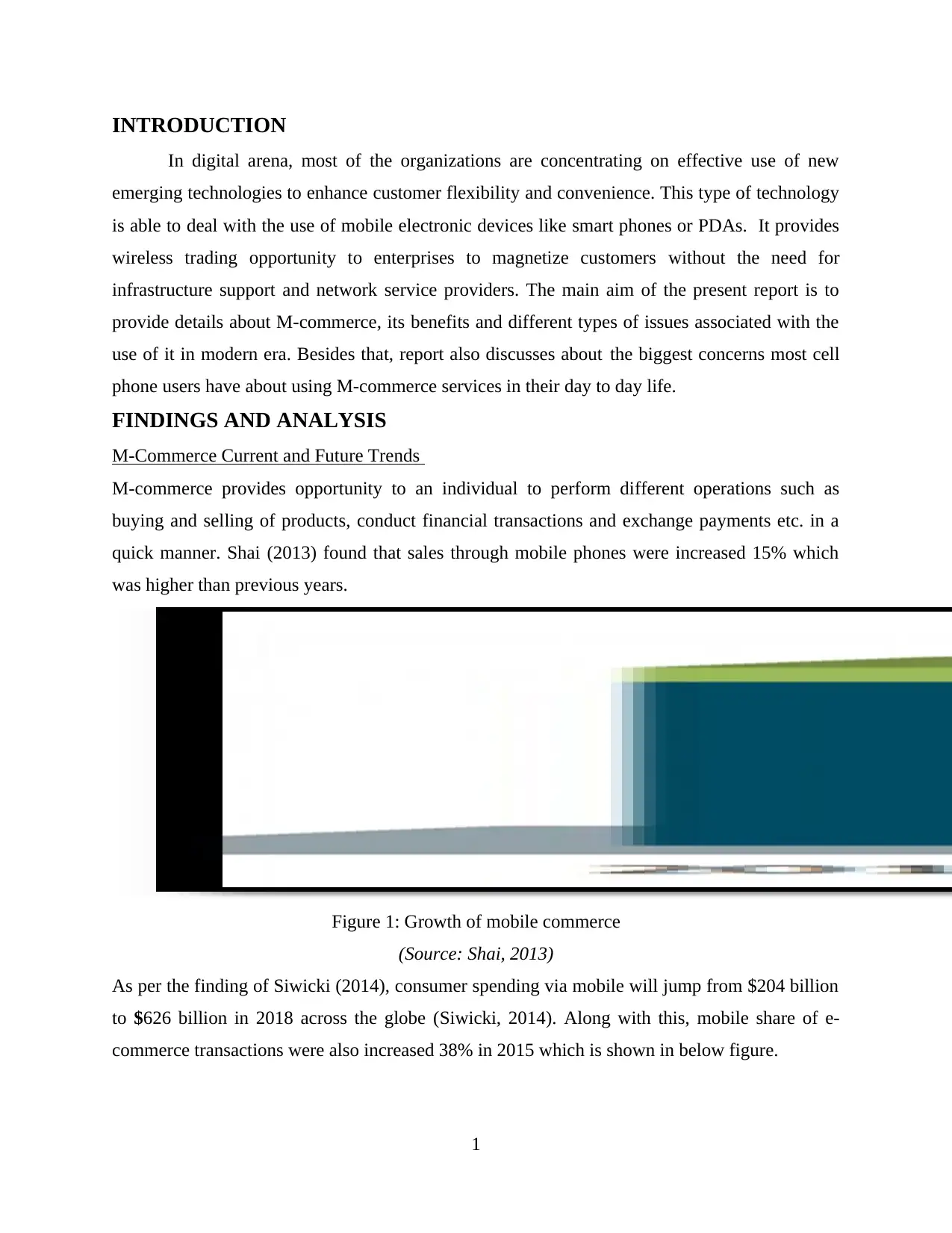
INTRODUCTION
In digital arena, most of the organizations are concentrating on effective use of new
emerging technologies to enhance customer flexibility and convenience. This type of technology
is able to deal with the use of mobile electronic devices like smart phones or PDAs. It provides
wireless trading opportunity to enterprises to magnetize customers without the need for
infrastructure support and network service providers. The main aim of the present report is to
provide details about M-commerce, its benefits and different types of issues associated with the
use of it in modern era. Besides that, report also discusses about the biggest concerns most cell
phone users have about using M-commerce services in their day to day life.
FINDINGS AND ANALYSIS
M-Commerce Current and Future Trends
M-commerce provides opportunity to an individual to perform different operations such as
buying and selling of products, conduct financial transactions and exchange payments etc. in a
quick manner. Shai (2013) found that sales through mobile phones were increased 15% which
was higher than previous years.
Figure 1: Growth of mobile commerce
(Source: Shai, 2013)
As per the finding of Siwicki (2014), consumer spending via mobile will jump from $204 billion
to $626 billion in 2018 across the globe (Siwicki, 2014). Along with this, mobile share of e-
commerce transactions were also increased 38% in 2015 which is shown in below figure.
1
In digital arena, most of the organizations are concentrating on effective use of new
emerging technologies to enhance customer flexibility and convenience. This type of technology
is able to deal with the use of mobile electronic devices like smart phones or PDAs. It provides
wireless trading opportunity to enterprises to magnetize customers without the need for
infrastructure support and network service providers. The main aim of the present report is to
provide details about M-commerce, its benefits and different types of issues associated with the
use of it in modern era. Besides that, report also discusses about the biggest concerns most cell
phone users have about using M-commerce services in their day to day life.
FINDINGS AND ANALYSIS
M-Commerce Current and Future Trends
M-commerce provides opportunity to an individual to perform different operations such as
buying and selling of products, conduct financial transactions and exchange payments etc. in a
quick manner. Shai (2013) found that sales through mobile phones were increased 15% which
was higher than previous years.
Figure 1: Growth of mobile commerce
(Source: Shai, 2013)
As per the finding of Siwicki (2014), consumer spending via mobile will jump from $204 billion
to $626 billion in 2018 across the globe (Siwicki, 2014). Along with this, mobile share of e-
commerce transactions were also increased 38% in 2015 which is shown in below figure.
1
Paraphrase This Document
Need a fresh take? Get an instant paraphrase of this document with our AI Paraphraser
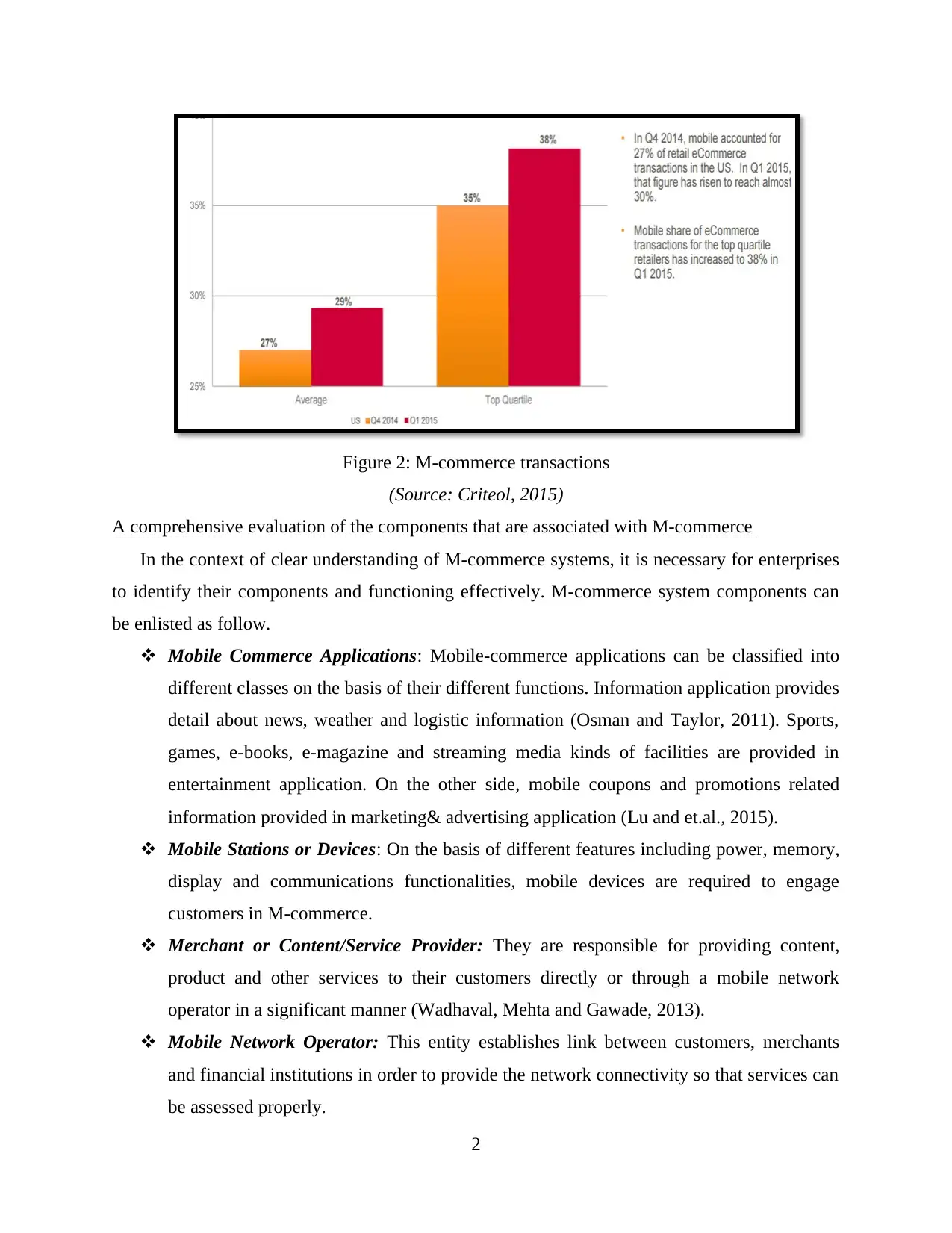
Figure 2: M-commerce transactions
(Source: Criteol, 2015)
A comprehensive evaluation of the components that are associated with M-commerce
In the context of clear understanding of M-commerce systems, it is necessary for enterprises
to identify their components and functioning effectively. M-commerce system components can
be enlisted as follow.
Mobile Commerce Applications: Mobile-commerce applications can be classified into
different classes on the basis of their different functions. Information application provides
detail about news, weather and logistic information (Osman and Taylor, 2011). Sports,
games, e-books, e-magazine and streaming media kinds of facilities are provided in
entertainment application. On the other side, mobile coupons and promotions related
information provided in marketing& advertising application (Lu and et.al., 2015).
Mobile Stations or Devices: On the basis of different features including power, memory,
display and communications functionalities, mobile devices are required to engage
customers in M-commerce.
Merchant or Content/Service Provider: They are responsible for providing content,
product and other services to their customers directly or through a mobile network
operator in a significant manner (Wadhaval, Mehta and Gawade, 2013).
Mobile Network Operator: This entity establishes link between customers, merchants
and financial institutions in order to provide the network connectivity so that services can
be assessed properly.
2
(Source: Criteol, 2015)
A comprehensive evaluation of the components that are associated with M-commerce
In the context of clear understanding of M-commerce systems, it is necessary for enterprises
to identify their components and functioning effectively. M-commerce system components can
be enlisted as follow.
Mobile Commerce Applications: Mobile-commerce applications can be classified into
different classes on the basis of their different functions. Information application provides
detail about news, weather and logistic information (Osman and Taylor, 2011). Sports,
games, e-books, e-magazine and streaming media kinds of facilities are provided in
entertainment application. On the other side, mobile coupons and promotions related
information provided in marketing& advertising application (Lu and et.al., 2015).
Mobile Stations or Devices: On the basis of different features including power, memory,
display and communications functionalities, mobile devices are required to engage
customers in M-commerce.
Merchant or Content/Service Provider: They are responsible for providing content,
product and other services to their customers directly or through a mobile network
operator in a significant manner (Wadhaval, Mehta and Gawade, 2013).
Mobile Network Operator: This entity establishes link between customers, merchants
and financial institutions in order to provide the network connectivity so that services can
be assessed properly.
2
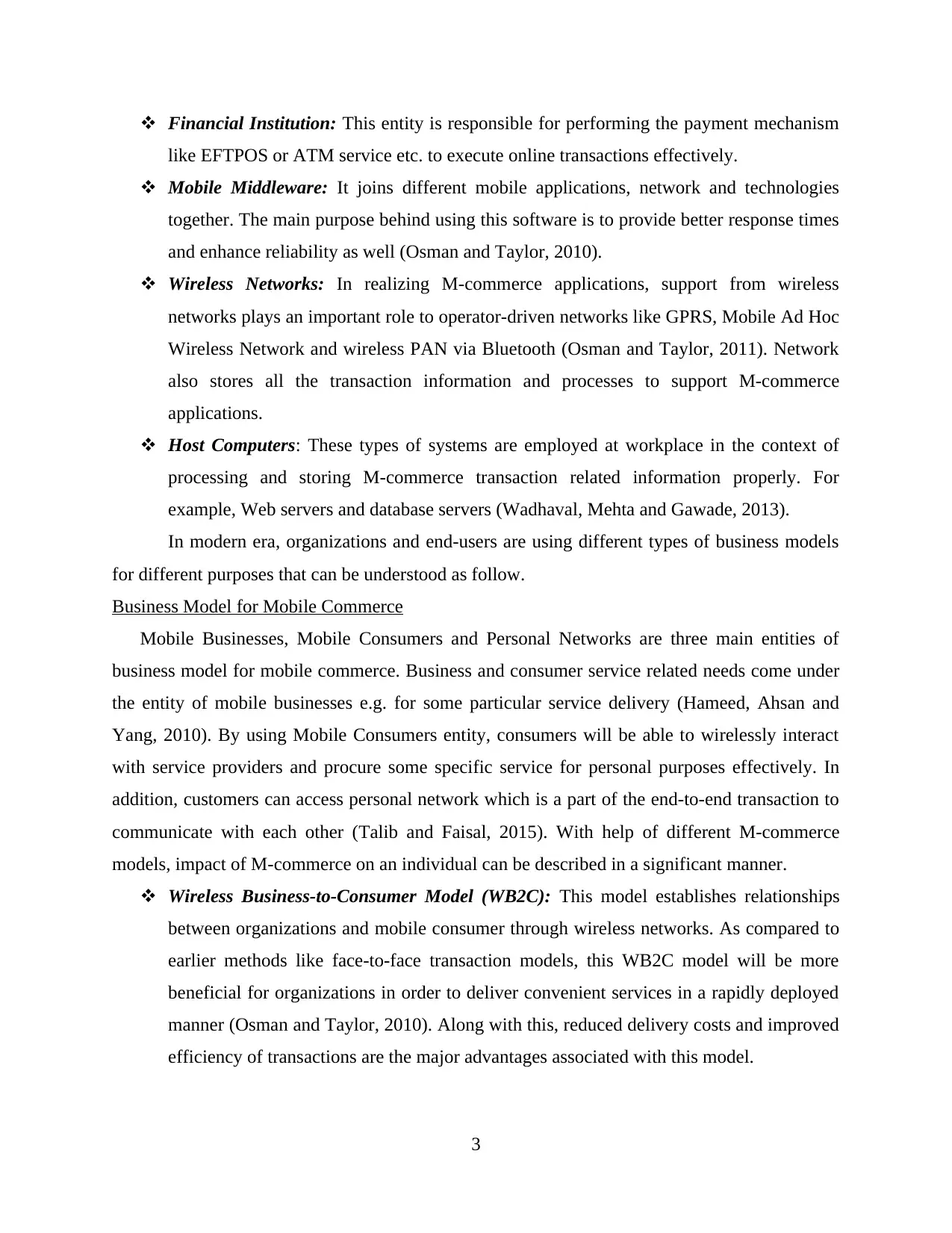
Financial Institution: This entity is responsible for performing the payment mechanism
like EFTPOS or ATM service etc. to execute online transactions effectively.
Mobile Middleware: It joins different mobile applications, network and technologies
together. The main purpose behind using this software is to provide better response times
and enhance reliability as well (Osman and Taylor, 2010).
Wireless Networks: In realizing M-commerce applications, support from wireless
networks plays an important role to operator-driven networks like GPRS, Mobile Ad Hoc
Wireless Network and wireless PAN via Bluetooth (Osman and Taylor, 2011). Network
also stores all the transaction information and processes to support M-commerce
applications.
Host Computers: These types of systems are employed at workplace in the context of
processing and storing M-commerce transaction related information properly. For
example, Web servers and database servers (Wadhaval, Mehta and Gawade, 2013).
In modern era, organizations and end-users are using different types of business models
for different purposes that can be understood as follow.
Business Model for Mobile Commerce
Mobile Businesses, Mobile Consumers and Personal Networks are three main entities of
business model for mobile commerce. Business and consumer service related needs come under
the entity of mobile businesses e.g. for some particular service delivery (Hameed, Ahsan and
Yang, 2010). By using Mobile Consumers entity, consumers will be able to wirelessly interact
with service providers and procure some specific service for personal purposes effectively. In
addition, customers can access personal network which is a part of the end-to-end transaction to
communicate with each other (Talib and Faisal, 2015). With help of different M-commerce
models, impact of M-commerce on an individual can be described in a significant manner.
Wireless Business-to-Consumer Model (WB2C): This model establishes relationships
between organizations and mobile consumer through wireless networks. As compared to
earlier methods like face-to-face transaction models, this WB2C model will be more
beneficial for organizations in order to deliver convenient services in a rapidly deployed
manner (Osman and Taylor, 2010). Along with this, reduced delivery costs and improved
efficiency of transactions are the major advantages associated with this model.
3
like EFTPOS or ATM service etc. to execute online transactions effectively.
Mobile Middleware: It joins different mobile applications, network and technologies
together. The main purpose behind using this software is to provide better response times
and enhance reliability as well (Osman and Taylor, 2010).
Wireless Networks: In realizing M-commerce applications, support from wireless
networks plays an important role to operator-driven networks like GPRS, Mobile Ad Hoc
Wireless Network and wireless PAN via Bluetooth (Osman and Taylor, 2011). Network
also stores all the transaction information and processes to support M-commerce
applications.
Host Computers: These types of systems are employed at workplace in the context of
processing and storing M-commerce transaction related information properly. For
example, Web servers and database servers (Wadhaval, Mehta and Gawade, 2013).
In modern era, organizations and end-users are using different types of business models
for different purposes that can be understood as follow.
Business Model for Mobile Commerce
Mobile Businesses, Mobile Consumers and Personal Networks are three main entities of
business model for mobile commerce. Business and consumer service related needs come under
the entity of mobile businesses e.g. for some particular service delivery (Hameed, Ahsan and
Yang, 2010). By using Mobile Consumers entity, consumers will be able to wirelessly interact
with service providers and procure some specific service for personal purposes effectively. In
addition, customers can access personal network which is a part of the end-to-end transaction to
communicate with each other (Talib and Faisal, 2015). With help of different M-commerce
models, impact of M-commerce on an individual can be described in a significant manner.
Wireless Business-to-Consumer Model (WB2C): This model establishes relationships
between organizations and mobile consumer through wireless networks. As compared to
earlier methods like face-to-face transaction models, this WB2C model will be more
beneficial for organizations in order to deliver convenient services in a rapidly deployed
manner (Osman and Taylor, 2010). Along with this, reduced delivery costs and improved
efficiency of transactions are the major advantages associated with this model.
3
⊘ This is a preview!⊘
Do you want full access?
Subscribe today to unlock all pages.

Trusted by 1+ million students worldwide
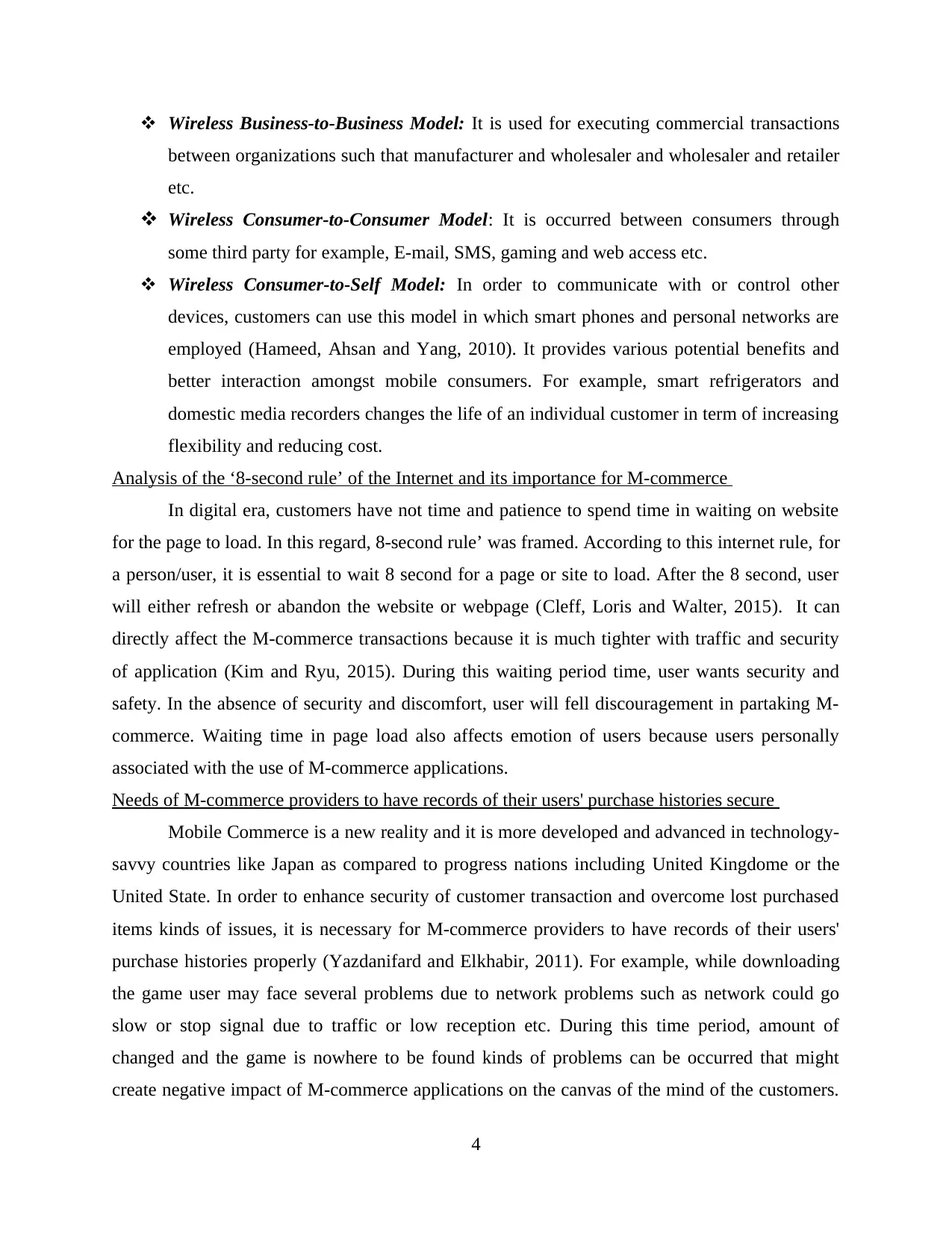
Wireless Business-to-Business Model: It is used for executing commercial transactions
between organizations such that manufacturer and wholesaler and wholesaler and retailer
etc.
Wireless Consumer-to-Consumer Model: It is occurred between consumers through
some third party for example, E-mail, SMS, gaming and web access etc.
Wireless Consumer-to-Self Model: In order to communicate with or control other
devices, customers can use this model in which smart phones and personal networks are
employed (Hameed, Ahsan and Yang, 2010). It provides various potential benefits and
better interaction amongst mobile consumers. For example, smart refrigerators and
domestic media recorders changes the life of an individual customer in term of increasing
flexibility and reducing cost.
Analysis of the ‘8-second rule’ of the Internet and its importance for M-commerce
In digital era, customers have not time and patience to spend time in waiting on website
for the page to load. In this regard, 8-second rule’ was framed. According to this internet rule, for
a person/user, it is essential to wait 8 second for a page or site to load. After the 8 second, user
will either refresh or abandon the website or webpage (Cleff, Loris and Walter, 2015). It can
directly affect the M-commerce transactions because it is much tighter with traffic and security
of application (Kim and Ryu, 2015). During this waiting period time, user wants security and
safety. In the absence of security and discomfort, user will fell discouragement in partaking M-
commerce. Waiting time in page load also affects emotion of users because users personally
associated with the use of M-commerce applications.
Needs of M-commerce providers to have records of their users' purchase histories secure
Mobile Commerce is a new reality and it is more developed and advanced in technology-
savvy countries like Japan as compared to progress nations including United Kingdome or the
United State. In order to enhance security of customer transaction and overcome lost purchased
items kinds of issues, it is necessary for M-commerce providers to have records of their users'
purchase histories properly (Yazdanifard and Elkhabir, 2011). For example, while downloading
the game user may face several problems due to network problems such as network could go
slow or stop signal due to traffic or low reception etc. During this time period, amount of
changed and the game is nowhere to be found kinds of problems can be occurred that might
create negative impact of M-commerce applications on the canvas of the mind of the customers.
4
between organizations such that manufacturer and wholesaler and wholesaler and retailer
etc.
Wireless Consumer-to-Consumer Model: It is occurred between consumers through
some third party for example, E-mail, SMS, gaming and web access etc.
Wireless Consumer-to-Self Model: In order to communicate with or control other
devices, customers can use this model in which smart phones and personal networks are
employed (Hameed, Ahsan and Yang, 2010). It provides various potential benefits and
better interaction amongst mobile consumers. For example, smart refrigerators and
domestic media recorders changes the life of an individual customer in term of increasing
flexibility and reducing cost.
Analysis of the ‘8-second rule’ of the Internet and its importance for M-commerce
In digital era, customers have not time and patience to spend time in waiting on website
for the page to load. In this regard, 8-second rule’ was framed. According to this internet rule, for
a person/user, it is essential to wait 8 second for a page or site to load. After the 8 second, user
will either refresh or abandon the website or webpage (Cleff, Loris and Walter, 2015). It can
directly affect the M-commerce transactions because it is much tighter with traffic and security
of application (Kim and Ryu, 2015). During this waiting period time, user wants security and
safety. In the absence of security and discomfort, user will fell discouragement in partaking M-
commerce. Waiting time in page load also affects emotion of users because users personally
associated with the use of M-commerce applications.
Needs of M-commerce providers to have records of their users' purchase histories secure
Mobile Commerce is a new reality and it is more developed and advanced in technology-
savvy countries like Japan as compared to progress nations including United Kingdome or the
United State. In order to enhance security of customer transaction and overcome lost purchased
items kinds of issues, it is necessary for M-commerce providers to have records of their users'
purchase histories properly (Yazdanifard and Elkhabir, 2011). For example, while downloading
the game user may face several problems due to network problems such as network could go
slow or stop signal due to traffic or low reception etc. During this time period, amount of
changed and the game is nowhere to be found kinds of problems can be occurred that might
create negative impact of M-commerce applications on the canvas of the mind of the customers.
4
Paraphrase This Document
Need a fresh take? Get an instant paraphrase of this document with our AI Paraphraser
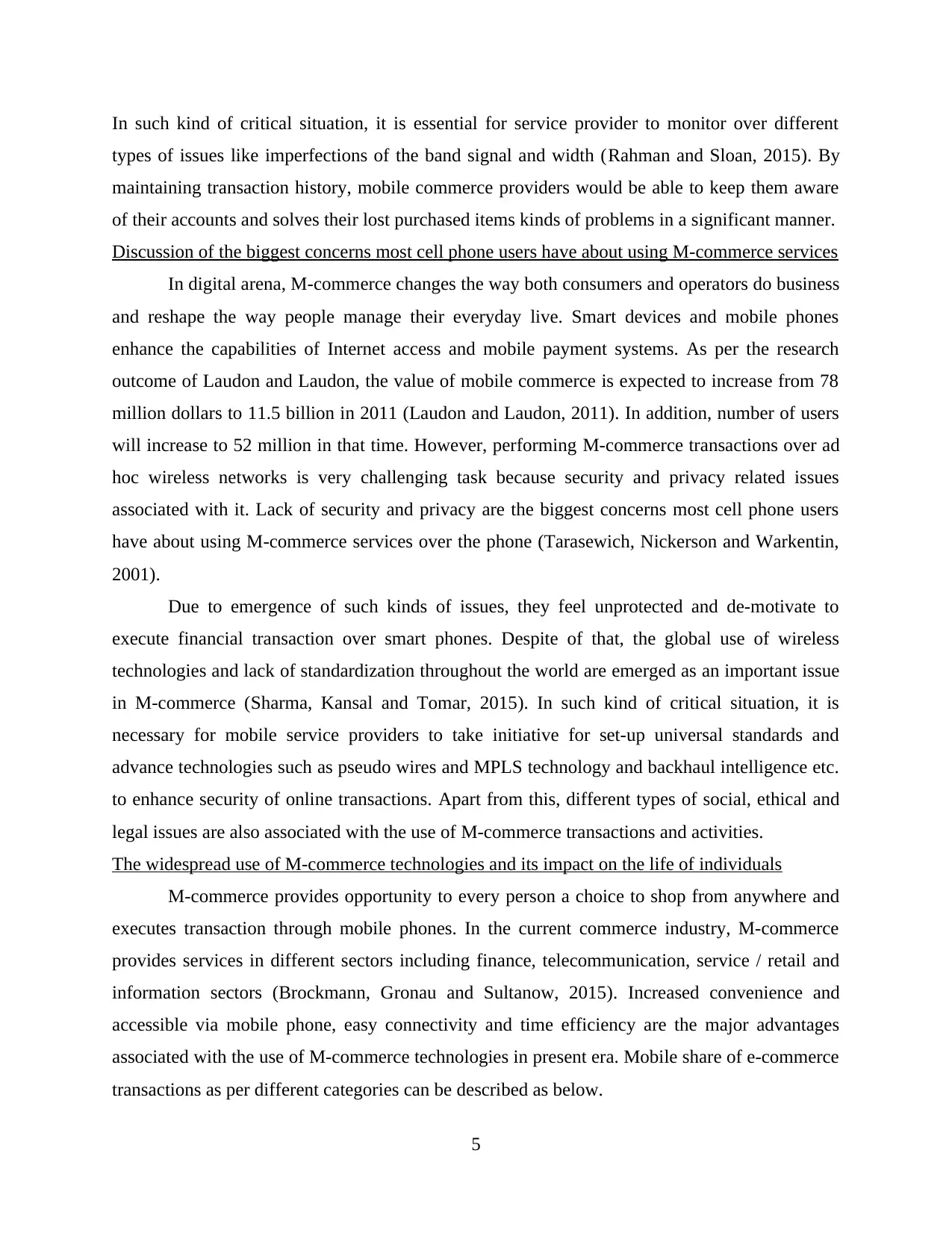
In such kind of critical situation, it is essential for service provider to monitor over different
types of issues like imperfections of the band signal and width (Rahman and Sloan, 2015). By
maintaining transaction history, mobile commerce providers would be able to keep them aware
of their accounts and solves their lost purchased items kinds of problems in a significant manner.
Discussion of the biggest concerns most cell phone users have about using M-commerce services
In digital arena, M-commerce changes the way both consumers and operators do business
and reshape the way people manage their everyday live. Smart devices and mobile phones
enhance the capabilities of Internet access and mobile payment systems. As per the research
outcome of Laudon and Laudon, the value of mobile commerce is expected to increase from 78
million dollars to 11.5 billion in 2011 (Laudon and Laudon, 2011). In addition, number of users
will increase to 52 million in that time. However, performing M-commerce transactions over ad
hoc wireless networks is very challenging task because security and privacy related issues
associated with it. Lack of security and privacy are the biggest concerns most cell phone users
have about using M-commerce services over the phone (Tarasewich, Nickerson and Warkentin,
2001).
Due to emergence of such kinds of issues, they feel unprotected and de-motivate to
execute financial transaction over smart phones. Despite of that, the global use of wireless
technologies and lack of standardization throughout the world are emerged as an important issue
in M-commerce (Sharma, Kansal and Tomar, 2015). In such kind of critical situation, it is
necessary for mobile service providers to take initiative for set-up universal standards and
advance technologies such as pseudo wires and MPLS technology and backhaul intelligence etc.
to enhance security of online transactions. Apart from this, different types of social, ethical and
legal issues are also associated with the use of M-commerce transactions and activities.
The widespread use of M-commerce technologies and its impact on the life of individuals
M-commerce provides opportunity to every person a choice to shop from anywhere and
executes transaction through mobile phones. In the current commerce industry, M-commerce
provides services in different sectors including finance, telecommunication, service / retail and
information sectors (Brockmann, Gronau and Sultanow, 2015). Increased convenience and
accessible via mobile phone, easy connectivity and time efficiency are the major advantages
associated with the use of M-commerce technologies in present era. Mobile share of e-commerce
transactions as per different categories can be described as below.
5
types of issues like imperfections of the band signal and width (Rahman and Sloan, 2015). By
maintaining transaction history, mobile commerce providers would be able to keep them aware
of their accounts and solves their lost purchased items kinds of problems in a significant manner.
Discussion of the biggest concerns most cell phone users have about using M-commerce services
In digital arena, M-commerce changes the way both consumers and operators do business
and reshape the way people manage their everyday live. Smart devices and mobile phones
enhance the capabilities of Internet access and mobile payment systems. As per the research
outcome of Laudon and Laudon, the value of mobile commerce is expected to increase from 78
million dollars to 11.5 billion in 2011 (Laudon and Laudon, 2011). In addition, number of users
will increase to 52 million in that time. However, performing M-commerce transactions over ad
hoc wireless networks is very challenging task because security and privacy related issues
associated with it. Lack of security and privacy are the biggest concerns most cell phone users
have about using M-commerce services over the phone (Tarasewich, Nickerson and Warkentin,
2001).
Due to emergence of such kinds of issues, they feel unprotected and de-motivate to
execute financial transaction over smart phones. Despite of that, the global use of wireless
technologies and lack of standardization throughout the world are emerged as an important issue
in M-commerce (Sharma, Kansal and Tomar, 2015). In such kind of critical situation, it is
necessary for mobile service providers to take initiative for set-up universal standards and
advance technologies such as pseudo wires and MPLS technology and backhaul intelligence etc.
to enhance security of online transactions. Apart from this, different types of social, ethical and
legal issues are also associated with the use of M-commerce transactions and activities.
The widespread use of M-commerce technologies and its impact on the life of individuals
M-commerce provides opportunity to every person a choice to shop from anywhere and
executes transaction through mobile phones. In the current commerce industry, M-commerce
provides services in different sectors including finance, telecommunication, service / retail and
information sectors (Brockmann, Gronau and Sultanow, 2015). Increased convenience and
accessible via mobile phone, easy connectivity and time efficiency are the major advantages
associated with the use of M-commerce technologies in present era. Mobile share of e-commerce
transactions as per different categories can be described as below.
5
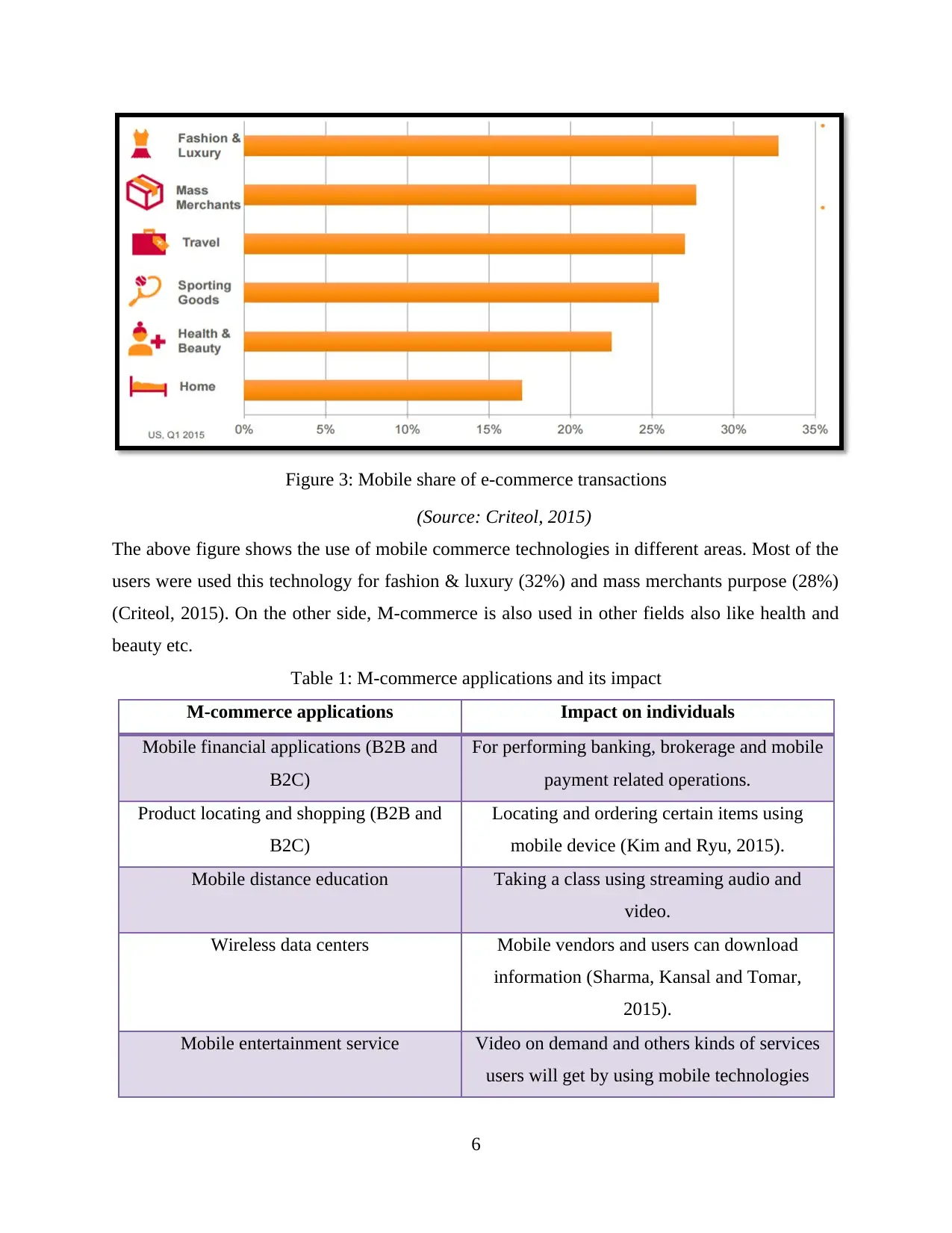
Figure 3: Mobile share of e-commerce transactions
(Source: Criteol, 2015)
The above figure shows the use of mobile commerce technologies in different areas. Most of the
users were used this technology for fashion & luxury (32%) and mass merchants purpose (28%)
(Criteol, 2015). On the other side, M-commerce is also used in other fields also like health and
beauty etc.
Table 1: M-commerce applications and its impact
M-commerce applications Impact on individuals
Mobile financial applications (B2B and
B2C)
For performing banking, brokerage and mobile
payment related operations.
Product locating and shopping (B2B and
B2C)
Locating and ordering certain items using
mobile device (Kim and Ryu, 2015).
Mobile distance education Taking a class using streaming audio and
video.
Wireless data centers Mobile vendors and users can download
information (Sharma, Kansal and Tomar,
2015).
Mobile entertainment service Video on demand and others kinds of services
users will get by using mobile technologies
6
(Source: Criteol, 2015)
The above figure shows the use of mobile commerce technologies in different areas. Most of the
users were used this technology for fashion & luxury (32%) and mass merchants purpose (28%)
(Criteol, 2015). On the other side, M-commerce is also used in other fields also like health and
beauty etc.
Table 1: M-commerce applications and its impact
M-commerce applications Impact on individuals
Mobile financial applications (B2B and
B2C)
For performing banking, brokerage and mobile
payment related operations.
Product locating and shopping (B2B and
B2C)
Locating and ordering certain items using
mobile device (Kim and Ryu, 2015).
Mobile distance education Taking a class using streaming audio and
video.
Wireless data centers Mobile vendors and users can download
information (Sharma, Kansal and Tomar,
2015).
Mobile entertainment service Video on demand and others kinds of services
users will get by using mobile technologies
6
⊘ This is a preview!⊘
Do you want full access?
Subscribe today to unlock all pages.

Trusted by 1+ million students worldwide
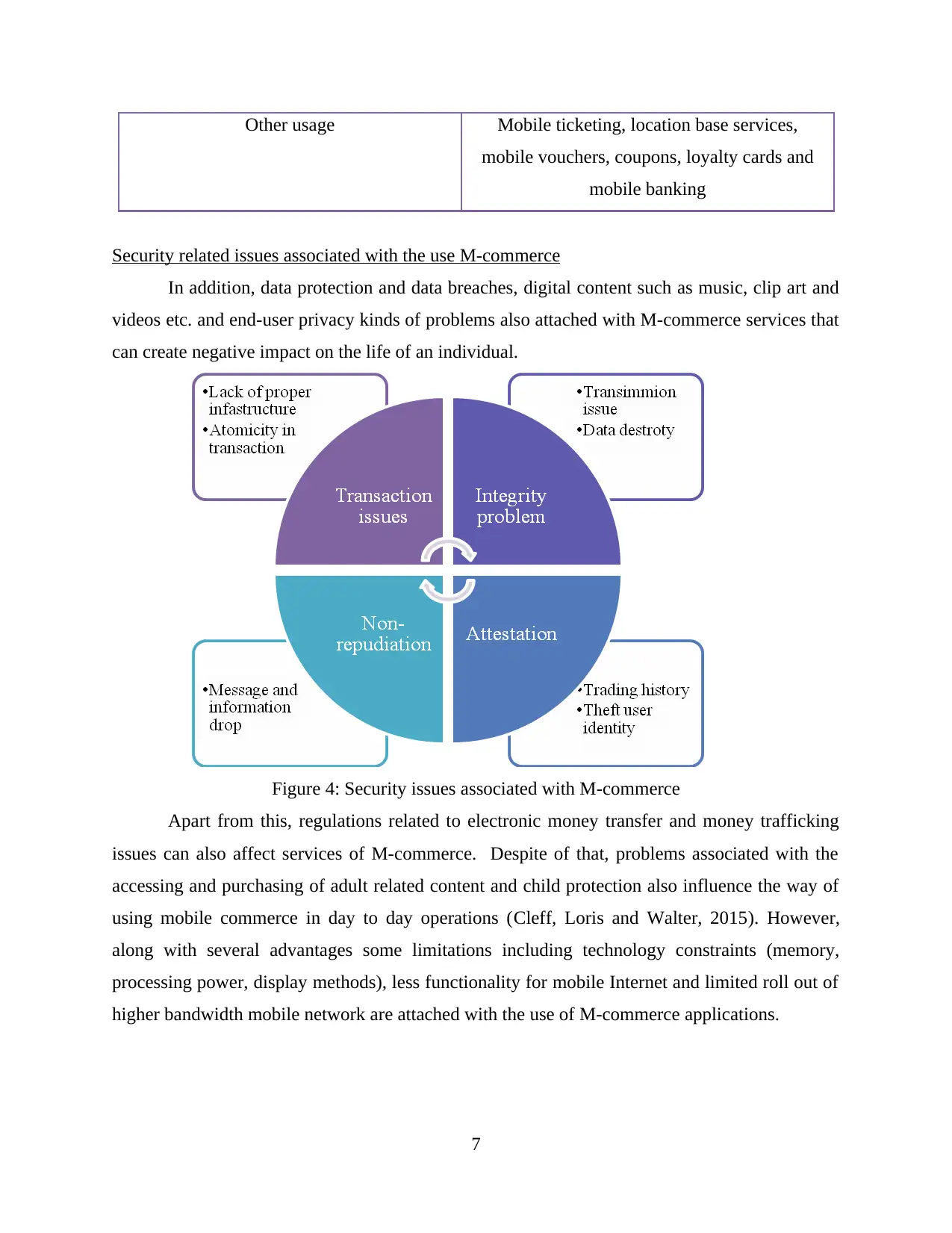
Other usage Mobile ticketing, location base services,
mobile vouchers, coupons, loyalty cards and
mobile banking
Security related issues associated with the use M-commerce
In addition, data protection and data breaches, digital content such as music, clip art and
videos etc. and end-user privacy kinds of problems also attached with M-commerce services that
can create negative impact on the life of an individual.
Figure 4: Security issues associated with M-commerce
Apart from this, regulations related to electronic money transfer and money trafficking
issues can also affect services of M-commerce. Despite of that, problems associated with the
accessing and purchasing of adult related content and child protection also influence the way of
using mobile commerce in day to day operations (Cleff, Loris and Walter, 2015). However,
along with several advantages some limitations including technology constraints (memory,
processing power, display methods), less functionality for mobile Internet and limited roll out of
higher bandwidth mobile network are attached with the use of M-commerce applications.
7
mobile vouchers, coupons, loyalty cards and
mobile banking
Security related issues associated with the use M-commerce
In addition, data protection and data breaches, digital content such as music, clip art and
videos etc. and end-user privacy kinds of problems also attached with M-commerce services that
can create negative impact on the life of an individual.
Figure 4: Security issues associated with M-commerce
Apart from this, regulations related to electronic money transfer and money trafficking
issues can also affect services of M-commerce. Despite of that, problems associated with the
accessing and purchasing of adult related content and child protection also influence the way of
using mobile commerce in day to day operations (Cleff, Loris and Walter, 2015). However,
along with several advantages some limitations including technology constraints (memory,
processing power, display methods), less functionality for mobile Internet and limited roll out of
higher bandwidth mobile network are attached with the use of M-commerce applications.
7
Paraphrase This Document
Need a fresh take? Get an instant paraphrase of this document with our AI Paraphraser
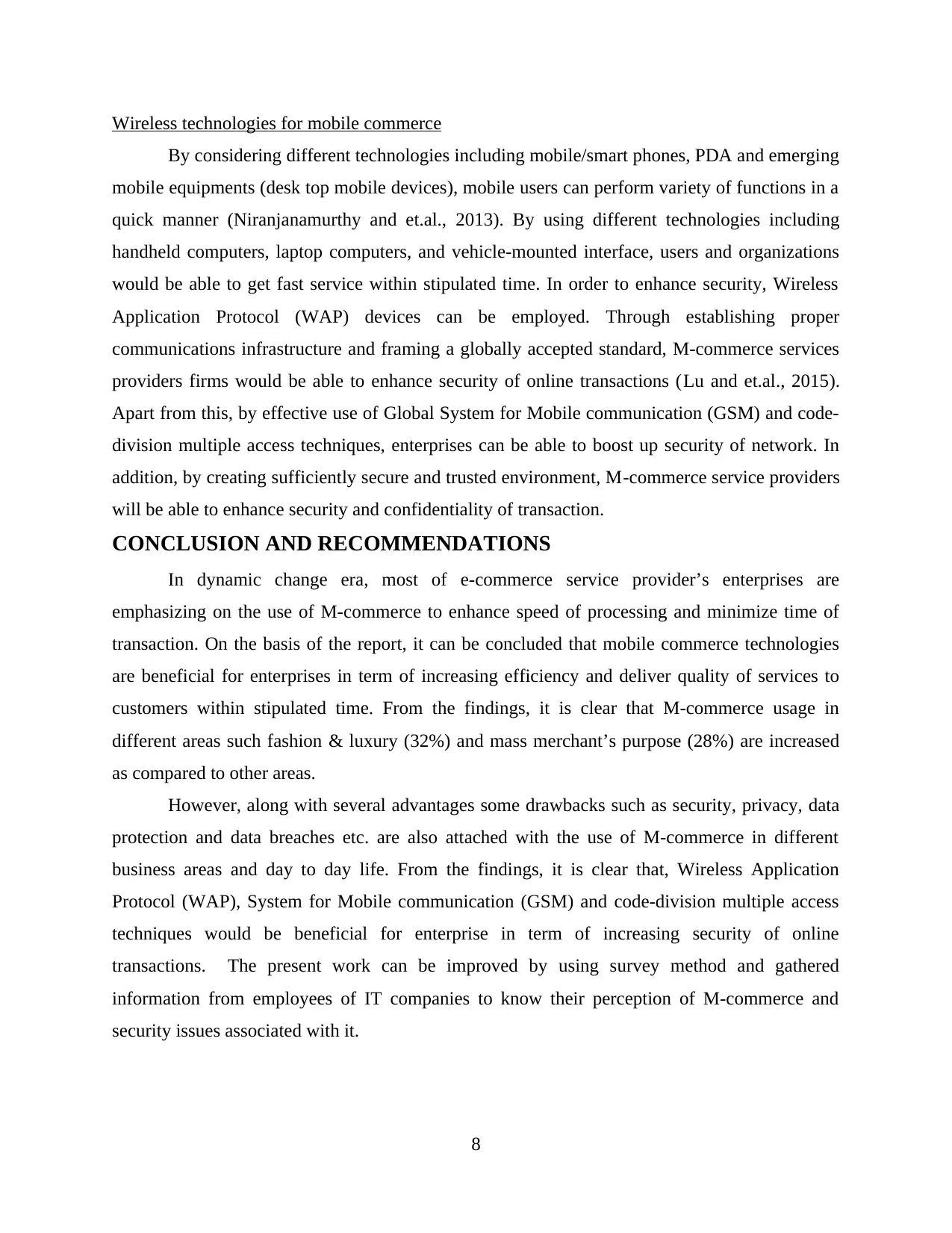
Wireless technologies for mobile commerce
By considering different technologies including mobile/smart phones, PDA and emerging
mobile equipments (desk top mobile devices), mobile users can perform variety of functions in a
quick manner (Niranjanamurthy and et.al., 2013). By using different technologies including
handheld computers, laptop computers, and vehicle-mounted interface, users and organizations
would be able to get fast service within stipulated time. In order to enhance security, Wireless
Application Protocol (WAP) devices can be employed. Through establishing proper
communications infrastructure and framing a globally accepted standard, M-commerce services
providers firms would be able to enhance security of online transactions (Lu and et.al., 2015).
Apart from this, by effective use of Global System for Mobile communication (GSM) and code-
division multiple access techniques, enterprises can be able to boost up security of network. In
addition, by creating sufficiently secure and trusted environment, M-commerce service providers
will be able to enhance security and confidentiality of transaction.
CONCLUSION AND RECOMMENDATIONS
In dynamic change era, most of e-commerce service provider’s enterprises are
emphasizing on the use of M-commerce to enhance speed of processing and minimize time of
transaction. On the basis of the report, it can be concluded that mobile commerce technologies
are beneficial for enterprises in term of increasing efficiency and deliver quality of services to
customers within stipulated time. From the findings, it is clear that M-commerce usage in
different areas such fashion & luxury (32%) and mass merchant’s purpose (28%) are increased
as compared to other areas.
However, along with several advantages some drawbacks such as security, privacy, data
protection and data breaches etc. are also attached with the use of M-commerce in different
business areas and day to day life. From the findings, it is clear that, Wireless Application
Protocol (WAP), System for Mobile communication (GSM) and code-division multiple access
techniques would be beneficial for enterprise in term of increasing security of online
transactions. The present work can be improved by using survey method and gathered
information from employees of IT companies to know their perception of M-commerce and
security issues associated with it.
8
By considering different technologies including mobile/smart phones, PDA and emerging
mobile equipments (desk top mobile devices), mobile users can perform variety of functions in a
quick manner (Niranjanamurthy and et.al., 2013). By using different technologies including
handheld computers, laptop computers, and vehicle-mounted interface, users and organizations
would be able to get fast service within stipulated time. In order to enhance security, Wireless
Application Protocol (WAP) devices can be employed. Through establishing proper
communications infrastructure and framing a globally accepted standard, M-commerce services
providers firms would be able to enhance security of online transactions (Lu and et.al., 2015).
Apart from this, by effective use of Global System for Mobile communication (GSM) and code-
division multiple access techniques, enterprises can be able to boost up security of network. In
addition, by creating sufficiently secure and trusted environment, M-commerce service providers
will be able to enhance security and confidentiality of transaction.
CONCLUSION AND RECOMMENDATIONS
In dynamic change era, most of e-commerce service provider’s enterprises are
emphasizing on the use of M-commerce to enhance speed of processing and minimize time of
transaction. On the basis of the report, it can be concluded that mobile commerce technologies
are beneficial for enterprises in term of increasing efficiency and deliver quality of services to
customers within stipulated time. From the findings, it is clear that M-commerce usage in
different areas such fashion & luxury (32%) and mass merchant’s purpose (28%) are increased
as compared to other areas.
However, along with several advantages some drawbacks such as security, privacy, data
protection and data breaches etc. are also attached with the use of M-commerce in different
business areas and day to day life. From the findings, it is clear that, Wireless Application
Protocol (WAP), System for Mobile communication (GSM) and code-division multiple access
techniques would be beneficial for enterprise in term of increasing security of online
transactions. The present work can be improved by using survey method and gathered
information from employees of IT companies to know their perception of M-commerce and
security issues associated with it.
8
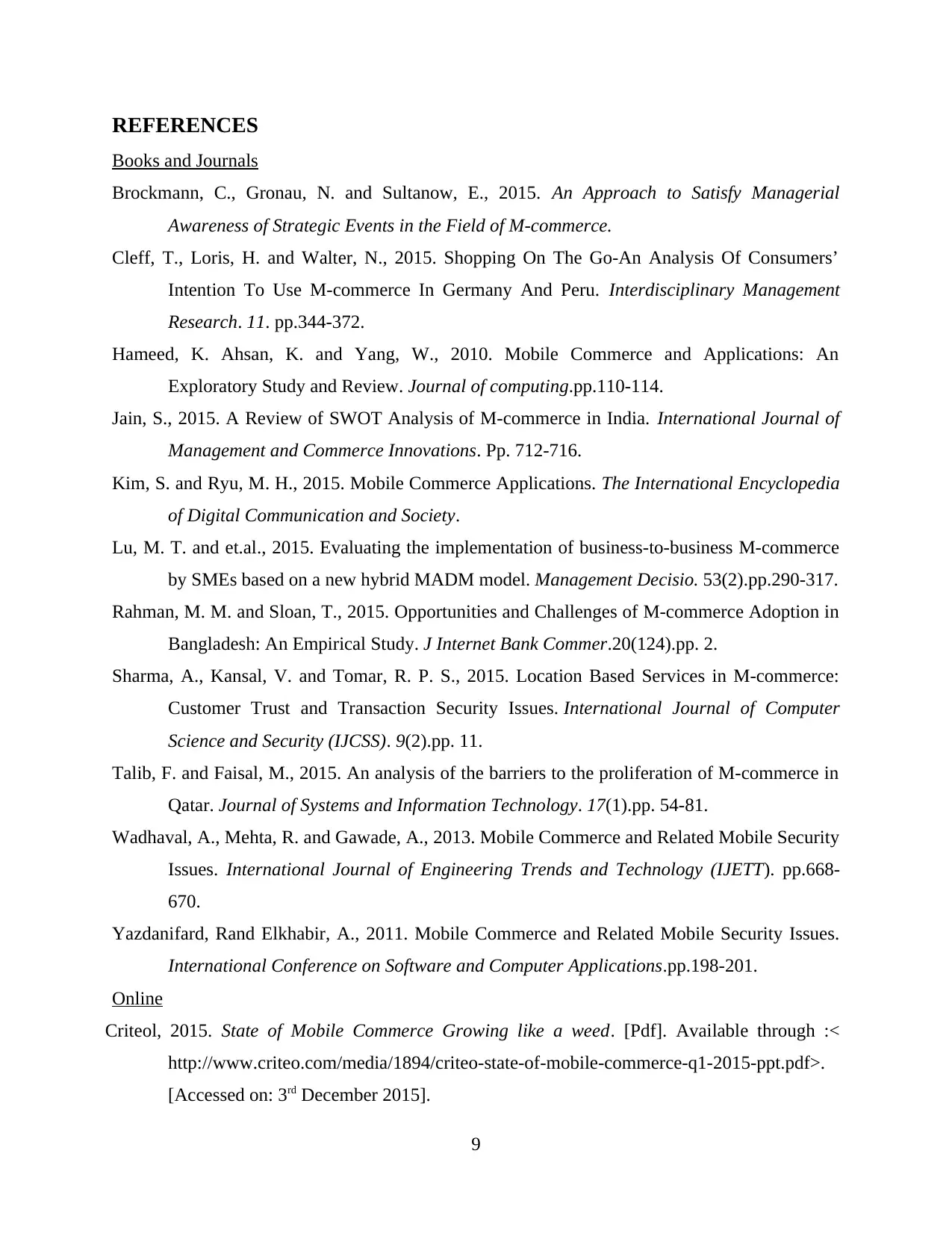
REFERENCES
Books and Journals
Brockmann, C., Gronau, N. and Sultanow, E., 2015. An Approach to Satisfy Managerial
Awareness of Strategic Events in the Field of M-commerce.
Cleff, T., Loris, H. and Walter, N., 2015. Shopping On The Go-An Analysis Of Consumers’
Intention To Use M-commerce In Germany And Peru. Interdisciplinary Management
Research. 11. pp.344-372.
Hameed, K. Ahsan, K. and Yang, W., 2010. Mobile Commerce and Applications: An
Exploratory Study and Review. Journal of computing.pp.110-114.
Jain, S., 2015. A Review of SWOT Analysis of M-commerce in India. International Journal of
Management and Commerce Innovations. Pp. 712-716.
Kim, S. and Ryu, M. H., 2015. Mobile Commerce Applications. The International Encyclopedia
of Digital Communication and Society.
Lu, M. T. and et.al., 2015. Evaluating the implementation of business-to-business M-commerce
by SMEs based on a new hybrid MADM model. Management Decisio. 53(2).pp.290-317.
Rahman, M. M. and Sloan, T., 2015. Opportunities and Challenges of M-commerce Adoption in
Bangladesh: An Empirical Study. J Internet Bank Commer.20(124).pp. 2.
Sharma, A., Kansal, V. and Tomar, R. P. S., 2015. Location Based Services in M-commerce:
Customer Trust and Transaction Security Issues. International Journal of Computer
Science and Security (IJCSS). 9(2).pp. 11.
Talib, F. and Faisal, M., 2015. An analysis of the barriers to the proliferation of M-commerce in
Qatar. Journal of Systems and Information Technology. 17(1).pp. 54-81.
Wadhaval, A., Mehta, R. and Gawade, A., 2013. Mobile Commerce and Related Mobile Security
Issues. International Journal of Engineering Trends and Technology (IJETT). pp.668-
670.
Yazdanifard, Rand Elkhabir, A., 2011. Mobile Commerce and Related Mobile Security Issues.
International Conference on Software and Computer Applications.pp.198-201.
Online
Criteol, 2015. State of Mobile Commerce Growing like a weed. [Pdf]. Available through :<
http://www.criteo.com/media/1894/criteo-state-of-mobile-commerce-q1-2015-ppt.pdf>.
[Accessed on: 3rd December 2015].
9
Books and Journals
Brockmann, C., Gronau, N. and Sultanow, E., 2015. An Approach to Satisfy Managerial
Awareness of Strategic Events in the Field of M-commerce.
Cleff, T., Loris, H. and Walter, N., 2015. Shopping On The Go-An Analysis Of Consumers’
Intention To Use M-commerce In Germany And Peru. Interdisciplinary Management
Research. 11. pp.344-372.
Hameed, K. Ahsan, K. and Yang, W., 2010. Mobile Commerce and Applications: An
Exploratory Study and Review. Journal of computing.pp.110-114.
Jain, S., 2015. A Review of SWOT Analysis of M-commerce in India. International Journal of
Management and Commerce Innovations. Pp. 712-716.
Kim, S. and Ryu, M. H., 2015. Mobile Commerce Applications. The International Encyclopedia
of Digital Communication and Society.
Lu, M. T. and et.al., 2015. Evaluating the implementation of business-to-business M-commerce
by SMEs based on a new hybrid MADM model. Management Decisio. 53(2).pp.290-317.
Rahman, M. M. and Sloan, T., 2015. Opportunities and Challenges of M-commerce Adoption in
Bangladesh: An Empirical Study. J Internet Bank Commer.20(124).pp. 2.
Sharma, A., Kansal, V. and Tomar, R. P. S., 2015. Location Based Services in M-commerce:
Customer Trust and Transaction Security Issues. International Journal of Computer
Science and Security (IJCSS). 9(2).pp. 11.
Talib, F. and Faisal, M., 2015. An analysis of the barriers to the proliferation of M-commerce in
Qatar. Journal of Systems and Information Technology. 17(1).pp. 54-81.
Wadhaval, A., Mehta, R. and Gawade, A., 2013. Mobile Commerce and Related Mobile Security
Issues. International Journal of Engineering Trends and Technology (IJETT). pp.668-
670.
Yazdanifard, Rand Elkhabir, A., 2011. Mobile Commerce and Related Mobile Security Issues.
International Conference on Software and Computer Applications.pp.198-201.
Online
Criteol, 2015. State of Mobile Commerce Growing like a weed. [Pdf]. Available through :<
http://www.criteo.com/media/1894/criteo-state-of-mobile-commerce-q1-2015-ppt.pdf>.
[Accessed on: 3rd December 2015].
9
⊘ This is a preview!⊘
Do you want full access?
Subscribe today to unlock all pages.

Trusted by 1+ million students worldwide
1 out of 13
Related Documents
Your All-in-One AI-Powered Toolkit for Academic Success.
+13062052269
info@desklib.com
Available 24*7 on WhatsApp / Email
![[object Object]](/_next/static/media/star-bottom.7253800d.svg)
Unlock your academic potential
Copyright © 2020–2025 A2Z Services. All Rights Reserved. Developed and managed by ZUCOL.





